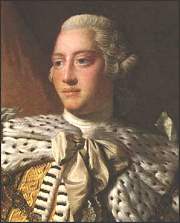George III's reign saw the revival of two-party politics after half a century of Whig dominance of political life, the loss of most of Britain's colonies in North America, protracted war with France and the beginning of the most rapid phase of British industrialisation.
Whig political supremacy under the earlier Hanoverians was challenged by the king's promotion of supporters of greater royal control of government, who came to be styled Tories (the name attached to earlier opponents of the Whigs in 1680-1715). The Whigs subsequently became the party increasingly of the country's newer commercial and industrial interests, becoming in the latter stages of the reign the party of limited social and political reform.
The king's experiment (1770-82) in government through the ministry of Lord North ended in the disastrous loss in the American War of Independence (1775-83) of the thirteen British North American colonies which became the United States of America.
Partly as a consequence of this, the British Government claimed Australia as the new place of penal servitude of convicts, a purpose that America had served up to that time. The eastern two-thirds of Australia had been claimed by Captain James Cook as a British possession in 1770. The first settlement was set up in Sydney in 1788.
The subsequent premiership of William Pitt, the Younger (1783-1801 and 1804-06) started the restoration of Britain's fortunes and the successful prosecution (largely through subsidies to European allies) of war with revolutionary and Napoleonic France (1793-1802 and 1803-1814) and the final defeat of Napoleon I in 1815.
Founded largely on technical advances in cotton manufacture from the 1760s onwards, Britain's industrialisation took off with the revival of trade in the 1780s, transforming the country within half a century from a predominantly rural society still earning its principal income from agriculture into the "workshop of the world" through its reliance on steam power and factory production.
Family
He was the son of Frederick, Prince of Wales and Augusta of Saxe-Gotha,
and grandson of King George II.Among his siblings was Princess Caroline
Matilda, who became Queen of Denmark and Norway for a few years. His first
cousin , and Caroline's husband, was Christian VII of Denmark, who also
had psychological problems, though these differed from that of George.
He married Charlotte of Mecklenburg-Strelitz in 1761 and they had nine sons and six daughters.:
- King George IV of the United Kingdom
- Frederick, Duke of York - (August 16, 1763 - January 5, 1827).
- King William IV of the United Kingdom
- Charlotte Augusta Matilda - (September 29, 1766 - October 6, 1828).
- Edward Augustus, Duke of Kent - (November 2, 1767 - January 23, 1820). He was the father of Queen Victoria
- Augusta Sophia - (November 8, 1768 - September 22, 1840).
- Elizabeth - (May 22, 1770 - January 10, 1840).
- King Ernest Augustus I of Hanover - (June 5, 1771 - November 18, 1851).
- Augustus Frederick, Duke of Sussex - (January 27, 1773 - April 21, 1843).
- Adolphus Frederick, Duke of Cambridge - (February 24, 1774 - July 8, 1850).
- Mary - (April 25, 1776 - April 30, 1857).
- Sophia - (November 3, 1777 -May 27, 1848).
- Octavius - (February 23, 1779 - May 3, 1783).
- Alfred - (September 22, 1780 - August 20, 1782).
- Amelia - (August 7, 1783 - November 2, 1810).
George is alleged to have married a Quakeress named Hannah Lightfoot in April 17, 1759, prior to his marriage to Charlotte in 1761. If such a marriage did exist, then his marriage to Charlotte was bigamous and all of George's successors have been usurpers. Some documents said to have supported the existence of this marriage were impounded in 1866 and studied by the Attorney-General. These are now in the Royal Archives in Windsor Castle, and their contents have never been made public.
Later Years
In 1811, George became permanently insane, something that was probably
triggered by the death of his youngest and favorite daughter, Princess
Amelia, from erysipelas. His son, George, Prince of Wales, took over ruling
Great Britain as Regent for the rest of George's reign.
King George III died in 1820 at Windsor Castle and was buried at St George's Chapel, Windsor. He was succeeded by his eldest son, George IV.
General Notes
The movie The Madness of King George explored the period of
his life in the 1780s when he had his first bout of madness.
| Preceded by:
George II |
List of British Monarchs | Succeeded by:
George IV |
